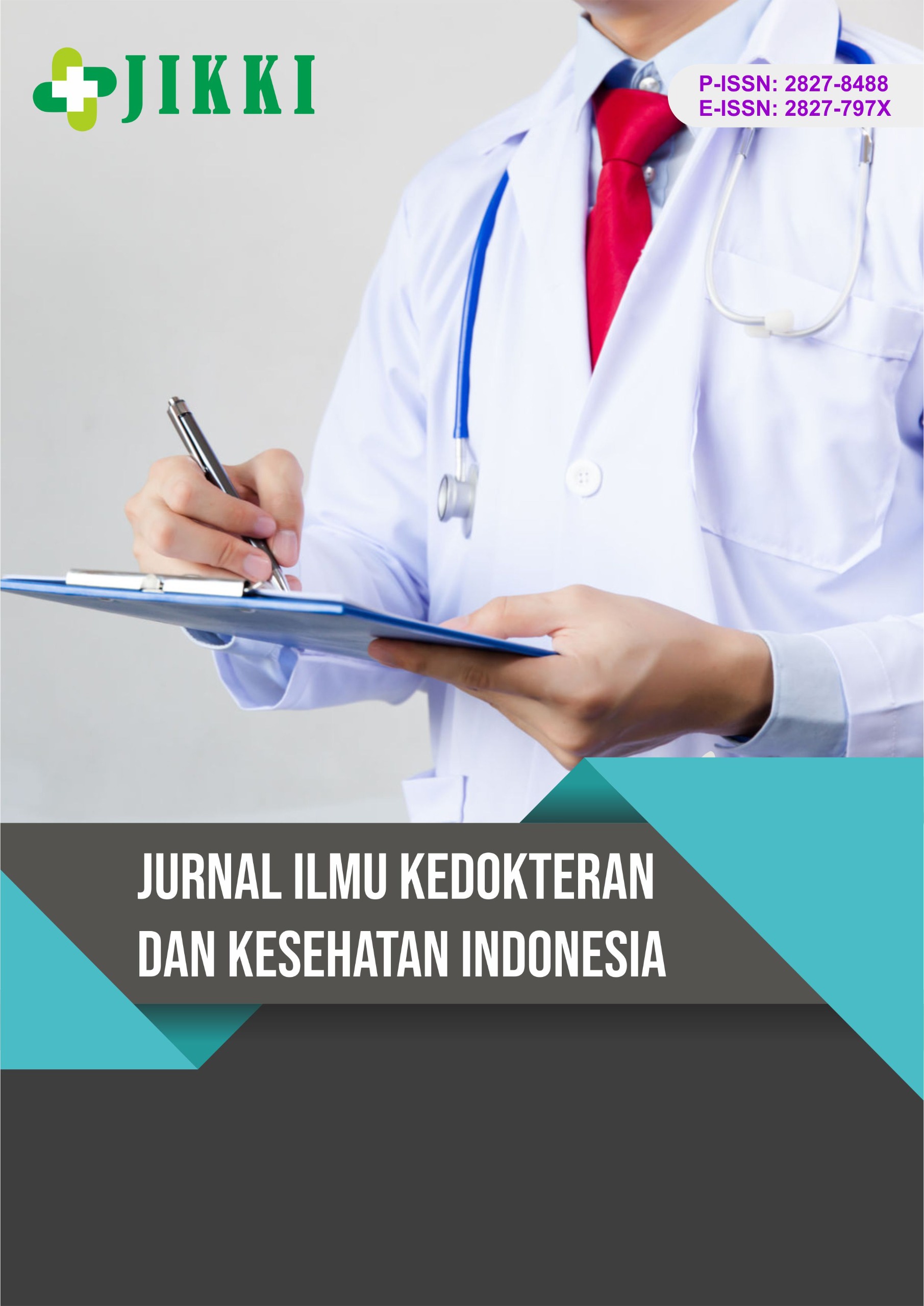Kajian Etnobotani Tumbuhan Obat Untuk Penyakit Malaria pada Masyarakat Kabupaten Keerom
DOI:
https://doi.org/10.55606/jikki.v5i3.8380Keywords:
Ethnobotany, Malaria, Medicinal Plants, Public, Traditional MedicineAbstract
Malaria remains a major public health problem in Papua, including Keerom District. Limited access to healthcare services has encouraged the local community to utilize traditional medicinal plants as an alternative therapy for malaria. This study aimed to document local knowledge regarding the use of antimalarial medicinal plants in Arso 7, Keerom District.The study was conducted in October 2023 using a descriptive qualitative design. The study population consisted of 500 households, with a purposive sample of 100 households. Primary data were collected through field observations, in-depth interviews using semi-structured questionnaires, documentation, and plant collection for botanical identification. Secondary data were obtained from relevant institutions and literature. Data were analyzed qualitatively by categorizing plant species based on local names, scientific names, plant parts used, preparation methods, and medicinal properties, and were presented descriptively.The findings revealed that the majority of respondents were aged 36–45 years (38%), female (68%), had primary school education (59%), and worked as housewives (51%). The most commonly used plants were papaya (Carica papaya) (45%), sambiloto (Andrographis paniculata) (40%), and brotowali (Tinospora crispa) (11%). Most plants were sourced from home gardens (60%), used in fresh form (100%), with leaves being the most frequently utilized part (98%), and predominantly prepared by boiling (90%).This study highlights that the traditional use of medicinal plants for malaria treatment remains strong within the Keerom community. Documenting this ethnobotanical knowledge is essential for preserving local wisdom and supporting the development of safe and sustainable antimalarial remedies.
References
Arisjulyanto, D., & Suweni, K. (2024). Pengaruh penyuluhan terhadap tingkat pengetahuan masyarakat tentang malaria di Kabupaten Kepulauan Yapen. Jurnal Kesehatan Tropis Indonesia, 2(1), 1–8. https://doi.org/10.63265/jkti.v2i1.51
Awotauw, E. L., & Panggabean, R. M. (2024). Analysis of ethnopharmacological studies on the use of the sambiloto plant in the treatment of malaria in the Asmat tribal community in Papua, Indonesia. Eureka Herba Indonesia, 5(2), 446–451. https://doi.org/10.37275/ehi.v5i2.118
Budiarti, M., Maruzy, A., Mujahid, R., Sari, A. N., Jokopriyambodo, W., Widayat, T., & Wahyono, S. (2020). The use of antimalarial plants as traditional treatment in Papua Island, Indonesia. Heliyon, 6(12), e05562. https://doi.org/10.1016/j.heliyon.2020.e05562
Darmawan, A., & Lipinwati. (2014). Gambaran obat tradisional yang digunakan penderita malaria di wilayah Puskesmas Simpang IV Sipin Kota Jambi 2014. Jambi Medical Journal, 2(2), 114–126.
Dehi, R. I., Iriani, F. A., & Damar, A. C. (2025). Ekstraksi dan identifikasi metabolit sekunder tumbuhan obat sebagai antimalaria di Kabupaten Keerom. Jurnal Riset Rumpun Ilmu Kedokteran (JURRIKE), 4(1), 437–451. https://doi.org/10.55606/jurrike.v4i1.5699
Elisabeth, O. J. L., Kurnianta, M., & P., D. (2019). Review artikel tradisional di Indonesia sebagai alternatif pengobatan malaria. Jurnal Acta Holostica Pharmaciana, 1(1), 33–43.
Hakim, L. (2014). Etnobotani dan manajemen kebun pekarangan rumah: Ketahanan pangan, kesehatan, dan agrowisata. Penerbit Selaras.
Indradi, R. B., Muhaimin, M., Barliana, M. I., & Khatib, A. (2023). Potential plant-based new antiplasmodial agent used in Papua Island, Indonesia. Plants, 12(9), 1813. https://doi.org/10.3390/plants12091813
Irmawati, A. (2016). Pemanfaatan tumbuhan obat tradisional dalam kehidupan masyarakat. Jurnal Kesehatan Masyarakat, 12(1), 45–52.
Irmawati. (2016). Etnobotani tumbuhan obat tradisional pada masyarakat di Desa Baruga Kecamatan Malili Kabupaten Luwu Timur (Skripsi, Fakultas Sains dan Teknologi, UIN Alauddin Makassar).
Kurniawan, Y. S., Priyangga, K. T. A., Krisbiantoro, P. A., & Imawan, A. C. (2021). Environmental risk factors that influence malaria incidence: Literature review. Journal of Multidisciplinary Applied Natural Science, 1(1), 1–12. https://doi.org/10.47352/jmans.v1i1.2
Limantoro, B., Nathanael, J. D., Athifa, D. A., Chandra, F. K., Zahra, A. A., Rizqi Ramadhan, M. I., Alfonso, G., Putri Lestari, I. D., Artika, I. D., Maulida Arisanti, N. Z., Djunaedi, R., & Nathanael, K. (2024). Effectiveness of Andrographis paniculata leaf extract as an antimalarial through Plasmodium heme polymerization inhibition. International Journal of Engineering Business and Social Science, 3(2), 223–232. https://doi.org/10.58451/ijebss.v3i2.200
Mawuntu, A. H. (2018). Epidemiologi malaria di Indonesia. Jurnal Biomedik, 10(2), 123–132.
Mawuntu, A. H. (2018). Malaria serebral. Jurnal Sinaps, 1(3), 45–52.
Muktiningsih, I., Arifin, H., & Yuliana, R. (2021). Pengetahuan lokal masyarakat tentang pemanfaatan tumbuhan obat di Indonesia. Jurnal Biologi Tropis, 21(2), 211–220.
Nelambo, T. A., Chrystomo, L. Y., & Zebua, L. I. (2022). Studi etnofarmasi dan skrining fitokimia ekstrak kulit batang tumbuhan Nelambo Suon (Rubiaceae) obat tradisional antimalaria Suku Yali di Distrik Heriapini Kabupaten Yahukimo. Jurnal Biologi Papua, 14(1), 34–41. https://doi.org/10.31957/jbp.1302
Regar, F. R. S. B., Novalina, D., & Solikah, M. P. (2021). Literature review: Perbandingan uji aktivitas ekstrak sambiloto (Andrographis paniculata) dengan ekstrak pepaya (Carica papaya Linn) sebagai antimalaria Plasmodium falciparum.
Rifai, M. A. (1998). Pemasakinian etnobotani Indonesia: Suatu keharusan demi peningkatan upaya pemanfaatan, pengembangan dan penguasaannya. Dalam Prosiding Seminar Nasional Etnobotani III (pp. 352–356). Denpasar-Bali.
Soemirat, J. (2011). Kesehatan lingkungan (Edisi revisi). UGM Press.
Suryadarma. (2008). Diktat kuliah etnobotani. FMIPA UNY.
Suswardany, D. L., Sibbritt, D. W., Supardi, S., Pardosi, J. F., Chang, S., & Adams, J. (2017). A cross-sectional analysis of traditional medicine use for malaria alongside free antimalarial drugs treatment amongst adults in high-risk malaria endemic provinces of Indonesia. PLoS ONE, 12(3), e0173522. https://doi.org/10.1371/journal.pone.0173522
Syarurachman. (2010). Mengenal penyakit melalui hasil pemeriksaan laboratorium. Universitas Gadjah Mada.
Tukayo, B. L. A., & Samalo, R. (2023). Inventory of medicinal plants: The treatment and prevention of malaria in the East Sentani District, Jayapura Regency. Jurnal Farmasi, 13(1), 25–36. https://doi.org/10.33751/jf.v13i1.6396
World Health Organization. (2023). World malaria report 2023. World Health Organization.
Yusuf, Y., Asri, R. M., Go, R., Zuhair, M. N., Kharuddin, K. M., Parenden, M. D. K., Saputra, M. D., Elim, D., Banjar, M. F., & Hartono. (2024). Synergism of anti-malarial effect of Carica papaya L. and Moringa oleifera leaf extract in mice. Majalah Obat Tradisional, 29(1), 100–106. https://doi.org/10.22146/mot.86703
Downloads
Published
How to Cite
Issue
Section
License
Copyright (c) 2025 Jurnal Ilmu Kedokteran dan Kesehatan Indonesia

This work is licensed under a Creative Commons Attribution-ShareAlike 4.0 International License.








